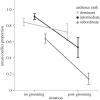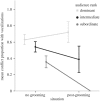Female vervet monkeys fine-tune decisions on tolerance versus conflict in a communication network
- PMID: 29142114
- PMCID: PMC5719174
- DOI: 10.1098/rspb.2017.1922
Female vervet monkeys fine-tune decisions on tolerance versus conflict in a communication network
Abstract
Group living promotes opportunities for both cooperation and competition. Selection on the ability to cope with such opposing social opportunities has been proposed as a driving force in the evolution of large brains in primates and other social species. However, we still know little about the degree of complexity involved in such social strategies. Here, we report advanced social strategies in wild vervet monkeys. Building on recent experimental evidence that subordinate females trade grooming for tolerance from higher-ranking individuals during foraging activities, we show that the audience composition strongly affects this trade. First, tolerance was lower if the audience contained individuals that outranked the subordinate partner, independently of audience size and kinship relationships. Second, we found a significant interaction between previous grooming and relative rank of bystanders: dominant subjects valued recent grooming by subordinates while intermediate ranked subjects valued the option to aggress subordinate partners in the presence of a dominant audience. Aggressors were also more likely to emit coalition recruitment calls if the audience contained individuals that outranked the subordinate partner. In conclusion, vervet monkeys include both recent grooming and knowledge about third-party relationships to make complex decisions when trading grooming for tolerance, leading to a finely balanced trade-off between reciprocation and opportunities to reinforce rank relationships.
Keywords: Machiavellian intelligence; audience effect; cognition; strategic behaviour; vervet monkeys.
© 2017 The Author(s).
Conflict of interest statement
We have no competing interests.
Figures




Similar articles
-
Testing for anticipation of partners' reciprocity and other social parameters: An experimental approach in wild vervet monkeys (Chlorocebus pygerythrus).J Comp Psychol. 2018 Nov;132(4):464-472. doi: 10.1037/com0000156. J Comp Psychol. 2018. PMID: 30451530
-
Third-party ranks knowledge in wild vervet monkeys (Chlorocebus aethiops pygerythrus).PLoS One. 2013;8(3):e58562. doi: 10.1371/journal.pone.0058562. Epub 2013 Mar 8. PLoS One. 2013. PMID: 23520521 Free PMC article.
-
Wild Vervet Monkeys Trade Tolerance and Specific Coalitionary Support for Grooming in Experimentally Induced Conflicts.Curr Biol. 2015 Nov 16;25(22):3011-6. doi: 10.1016/j.cub.2015.10.016. Epub 2015 Nov 5. Curr Biol. 2015. PMID: 26549255
-
The consistency of individual centrality across time and networks in wild vervet monkeys.Am J Primatol. 2021 Feb;83(2):e23232. doi: 10.1002/ajp.23232. Epub 2021 Jan 19. Am J Primatol. 2021. PMID: 33464611
-
Primates are living links to our past: The contribution of comparative studies with wild vervet monkeys to the field of social cognition.Cortex. 2019 Sep;118:65-81. doi: 10.1016/j.cortex.2019.03.007. Epub 2019 Mar 21. Cortex. 2019. PMID: 30987738 Review.
Cited by
-
Predictability and variability of association patterns in sooty mangabeys.Behav Ecol Sociobiol. 2020;74(4):46. doi: 10.1007/s00265-020-2829-y. Epub 2020 Mar 23. Behav Ecol Sociobiol. 2020. PMID: 32226199 Free PMC article.
-
Executive function mediates age-related variation in social integration in female vervet monkeys (Chlorocebus sabaeus).Geroscience. 2024 Feb;46(1):841-852. doi: 10.1007/s11357-023-00820-7. Epub 2023 May 23. Geroscience. 2024. PMID: 37217631 Free PMC article.
References
-
- Humphrey NK. 1976. The social function of intellect. In Growing points in ethology (eds Bateson PPG, Hinde RA), pp. 303–317. Cambridge, UK: Cambridge University Press.
-
- Barton RA, Dunbar RIM. 1997. Evolution of the social brain. Cambridge, UK: Cambridge University Press.
-
- McGregor PK. 2005. Animal communication networks. Cambridge, UK: Cambridge University Press.
MeSH terms
LinkOut - more resources
Full Text Sources
Other Literature Sources

